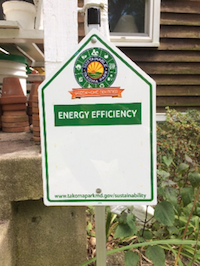This is the final post in a three-part series on understanding and increasing investments in energy efficiency by businesses and individuals. In the first post, we estimated these US investments total about $60-115 billion per year. In the second post, we discussed what motivates many households and businesses to invest in energy efficiency. This post builds on the first two and discusses approaches that could increase such investments in the future.
No more than one-fourth of households and businesses, on average, adopt efficiency measures (see the second post). If this number seems surprisingly small to you, we agree. These upgrades save money, improve health, and increase productivity, so why aren’t investment levels much higher?
Based on her surveys, Suzanne Shelton suggests there are four key reasons: (1) most people prefer to spend money on aesthetics; (2) homes and buildings are meeting expectations (e.g., 79% of business decision-makers and 47% of homeowners think they are already efficient); (3) some efficiency home improvements don’t save money (e.g., payback periods may be long or non-existent); and (4) even if they care about the environment, they are not prioritizing homes and buildings, even though homes and buildings often have the largest impact on their energy use.
Other factors may explain why businesses don’t invent in efficiency. Based on several years of interactions with hundreds of public- and private-sector partners, Maria Vargas, the director of DOE’s Better Buildings Challenge, suggested to us five important reasons: (1) more efficient technology is seen as expensive, riskier, and harder to maintain and operate; (2) facility managers and building operators don’t have time to implement energy efficiency strategies or are short-staffed and without a team of experts to help; (3) there are challenges getting senior leadership on board; (4) information on building energy performance is either non-existent or hard to access; and (5) a lack of financing and/or up-front capital makes it difficult to make long-term investments.
How do we address these challenges? On the one hand, annual efficiency investments of $60-115 billion are nothing to sneeze at. We’re doing some things right and can — and should — build on what is working. On the other hand, to reach people and businesses not embracing efficiency, we also need to try new approaches. Here are 10 suggestions to increase investments in those two categories.
Doing What We’ve Been Doing but Better and Deeper
1) Work with customers with a predilection to make efficiency investments
Some customers, such as large businesses and the well-to-do, are investing more in efficiency than others. We can work from our core by encouraging these customers to do more while also working on adjoining groups of customers such as medium-sized businesses and middle-income consumers.
2) Document and promote the non-energy benefits of energy efficiency
Financial messages can be a double-edged sword (see second post), and we should not overly emphasize them. Health, comfort, worker and factory productivity, and environmental protection can be important as motivating factors. These benefits should be better documented and promoted more, often breaking them down into specifics that people care about, such as less-drafty homes or reduced worker sick days.
3) Improve motivational tools and marketing
Benchmarking performance, such as for large buildings (as many cities are doing) and individual households (as many utilities are doing) helps owners with below-average performance identify themselves and can motivate improvement. Just like people use Fitbits to count their daily steps and get in shape, building operators can keep track of their buildings’ performance and improve their buildings’ fitness. More cities should take action and extend benchmarking to smaller buildings, including homes.
Many purchase decisions are made from the heart, not the brain. Making links to things people care about, such as their kids and communities, telling stories people can relate to, and highlighting social norms (“good citizens are doing it”) can all help. For example, Graziano and Gillingham have documented the influence of neighbors in the spread of solar photovoltaic system adoption, and Noonan, Hsieh, and Matisoff have shown how the adoption of zoned HVAC systems spread among neighbors “like a contagion.” We can do the same for other energy efficiency investments, as the City of Takoma Park, Maryland, is trying to do by placing signs that recognize sustainability champions (see photo).
4) Expand availability of easy-to-use and affordable financing
A common barrier to investment is upfront costs, and financing can help. A variety of easy-to-use financing strategies, such as on-bill financing (OBF) and property-assessed clean energy (PACE) financing, are gaining currency in a few areas but should be expanded substantially. OBF includes a variety called Pay As You Save (PAYS), which has been particularly popular with rural electric co-ops. Another creative solution used by some large customers is internal revolving funds, in which capital is provided or raised for an initial project, and the money saved is put into a revolving fund to finance additional energy-saving projects (for example, this approach has been successfully used by the Spectrum Healthcare Sustainability Fund). And yet another creative option is to combine solar and energy efficiency financing as PosiGen is now doing in Connecticut and Louisiana for moderate-income households.
5) Continue and expand policies that are proven to work
Building codes, appliance and vehicle efficiency standards, utility-sector efficiency programs, ENERGY STAR®, and energy saving performance contracts are all effective energy savers. These policies should be continued and expanded in regions of the country such as the Southeast and the Great Plains that presently have only limited efforts.
Trying New Approaches
To reach people and businesses not embracing efficiency, we also need to try new approaches. For example, smaller businesses and moderate-income households are less likely to make efficiency investments and may particularly benefit from new approaches (see second post). There is also growing interest among efficiency practitioners in various energy efficiency services that have the potential to reach new customers.
6) Provide new services
Most small businesses and households have limited time and expertise to think about energy efficiency. The same applies to many larger customers. For these customers, simple services provided by someone else would be useful – all the customer needs to do is say “yes.” For example, PG&E is experimenting with pay-for-performance weatherization, whereby the utility will reimburse contractors based on the energy savings they achieve. A start-up, Forgitit, is offering residential energy monitoring services for $30 per year, including rate monitoring, usage monitoring, energy efficiency monitoring, real-time billing monitoring, and automatic rate-switching when rates change. In Europe, Energiesprong has developed approaches for mass retrofits to public and other types of multifamily housing; NYSERDA is working with Energiesprong to bring the approach to the US.
For commercial users, firms such as Agilis Energy, AtSite, Energy Savvy, and FirstFuel offer energy use analysis, remote monitoring, and troubleshooting services. A field study on three buildings that were already ENERGY STAR® certified found 13% average energy savings for one of these services, achieving performance substantially beyond the qualifying levels for the ENERGY STAR® Buildings Program. Also, there are new private-sector start-ups that are offering financing and other services for small and medium-sized commercial customers, such as Joule Assets, Lime Energy, Noesis, and SparkFund. Going a step further, the German government is offering funding for new “smart” energy monitoring and savings systems provided to customers in the residential, commercial, or industrial sectors. The goal is to create systems that measure actual savings using metered data. A few ventures have been funded, but it is too early to say how they are doing.
7) Take advantage of home and building purchases and refinancing
Recent home purchasers and households with children are more likely to make home improvements (see second post). Energy efficiency services can be specifically targeted to them. Another opportunity is to offer efficiency upgrades to households during major events, such as moving to a new home or refinancing a mortgage. Refinancing happens roughly every decade for many commercial buildings. The New York City Energy Efficiency Corporation, for example, has had some success with this approach. Perhaps the same could be done with residential refinancing, although such loans may move too quickly to add an efficiency package. Another interesting idea is being tried in Belgium, France, and Germany, where homeowners are given a comprehensive energy audit. The data are used to develop a multi-year renovation plan that can be gradually implemented. Online “passports” are being set up to store information, so it is easy for homeowners and their contractors to take the next step.
8) Encourage continuous improvement
For large industrial and commercial energy users, the International Standards Organization (ISO) 50001 process has been established to encourage firms to make investments in ongoing programs that manage their energy use, including making commitments to continuous improvement. The US Department of Energy’s (DOE) 50001 Ready initiative has resources to assist. Going a step further, several governments in Europe have given firms tax reductions for implementing energy management programs (see here and here). As a result, as of 2015, there were nearly 6,000 ISO 50001-certified firms in Germany, compared to about 50 in the United States.
9) Work upstream
Instead of working home by home and building by building, sometimes it is possible to work with manufacturers and trade associations to serve many customers at once. For example, DOE offered the Rooftop Challenge to spur manufacturers to develop and market improved-efficiency rooftop air conditioners. Several manufacturers developed products. DOE also worked with large purchasers such as Target to make substantial purchases. In the past, similar efforts have focused on residential refrigerators and clothes washers. Likewise, in Europe, several countries have entered into voluntary agreements with industrial trade associations. The associations, on behalf of their members, agree to undertake various energy management actions to meet specified improvement targets, with the governments providing assistance of various sorts.
10) Increase local leadership and community action
While past US efficiency efforts have often been at the utility or state levels, there is great potential to do much more at the local level, where many people and businesses have a strong connection. For example, ACEEE prepares a biennial City Energy Efficiency Scorecard to look at large US cities. Boston has perennially ranked first and features efforts such as the Renew Boston program and building energy benchmarking and transparency requirements. But smaller communities can also do a lot. Notable examples include Charlottesville, VA, which offers a special tax rate for select energy-efficient residential and commercial buildings, and Hood River, OR, Marshfield, MA, and Bainbridge, WA, where energy retrofits have been intensely marketed as part of a community-wide initiative, achieving much higher participation rates than normal in the process.
Conclusions
US businesses and households are investing roughly $60-115 billion in energy efficiency each year. These investments were 8-9% higher in 2016 than in 2015 (see first post). To continue and accelerate this growth, we need to continue doing what we’ve been doing (but better and deeper), and also try new approaches such as encouraging new service offerings. This post provides some starting points, but we encourage additional creative ideas. Please comment on this blog and share your ideas with us.




